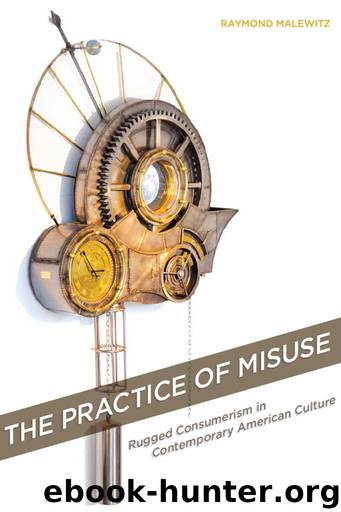The Practice of Misuse by Malewitz Raymond

Author:Malewitz, Raymond [Malewitz, Raymond]
Language: eng
Format: epub
Publisher: Stanford University Press
Published: 2014-03-12T16:00:00+00:00
5
Ritual, Play, and Neoliberal Rugged Consumerism
Giorgio Agamben dedicates a chapter of his book Infancy and History (1978) to the relationship between ritual and play. Following Lévi-Strauss, he initially classifies the terms as antithetical:
[T]he function of rites is to adjust the contradiction between mythic past and present, annulling the interval separating them and reabsorbing all events into the synchronic structure. Play, on the other hand, furnishes a symmetrically opposed operation: it tends to break the connection between past and present, and to break down and crumble the whole structure into events. If ritual is therefore a machine for transforming diachrony into synchrony, play, conversely, is a machine for transforming synchrony into diachrony. (83)
For Agamben, the difference between play and ritual is most visible in encounters with certain kinds of objects—most prominently toys, which he aligns with Lévi-Strauss’s bricolage. Both categories of objects use “‘crumbs’ or ‘scraps’ belonging to other structural wholes,” and both “belonged—once, no longer, to the realm of the sacred or of the practical-economic” (81, 80). To play with an object is to remove it from certain networks of power that stabilize its use-value and to therefore “break the [object’s] connection between past and present.” Ritualized interactions with objects serve the opposite function of stabilizing that value through the instantiation of laws of sanctioned use.
Agamben ends his argument by suggesting that the conversion of sacred or practical objects into toys (or toys back into sacred or practical objects) is never complete, because “every game . . . contains a ritual aspect and every rite an aspect of play, which often makes it awkward to distinguish one from the other.” From this overlap, he concludes: “we can regard ritual and play not as two distinct machines but as a single machine, a single binary system, which is articulated across two categories which cannot be isolated and across whose correlation and difference the very functioning of the system is based” (83–84). Agamben’s discussion of the overlap between ritual and play—between synchronic and diachronic tendencies—offers insight into the difficulties of positioning rugged consumerism as a critique of the “practical-economic” structures of late capitalism, particularly given the neoliberal philosophies through which this system is disseminated. On one hand, playful acts of rugged consumerism separate objects from their original use-values and replace older “practical-economic” behaviors with novel and potentially oppositional ones. On the other hand, these activities take place within an economic system predicated upon the creative destruction and reassembly of consumer desires, objects, industries, and workers and which, as Fredric Jameson (among others) has shown, depends upon the conversion of historical behaviors into a playful and politically ineffectual pastiche. As Jameson argues, after the exhaustion of the “high modernist ideology of style . . . the producers of culture have nowhere to turn but to the past” (Postmodernism, 17–18). The emergent “historicism” in art is characterized by “the random cannibalization of all the styles of the past, the play of random stylistic allusions, and in general what Henri Lefebvre has called the primacy of the ‘neo’” (Postmodernism, 18).
Download
This site does not store any files on its server. We only index and link to content provided by other sites. Please contact the content providers to delete copyright contents if any and email us, we'll remove relevant links or contents immediately.
Influence: The Psychology of Persuasion by Robert B. Cialdini(4715)
The Miracle Morning by Hal Elrod(4637)
The Hacking of the American Mind by Robert H. Lustig(4318)
Pre-Suasion: A Revolutionary Way to Influence and Persuade by Robert Cialdini(4145)
Unlabel: Selling You Without Selling Out by Marc Ecko(3587)
Ogilvy on Advertising by David Ogilvy(3506)
Hidden Persuasion: 33 psychological influence techniques in advertising by Marc Andrews & Matthijs van Leeuwen & Rick van Baaren(3472)
Purple Cow by Seth Godin(3139)
Who Can You Trust? by Rachel Botsman(3087)
Kick Ass in College: Highest Rated "How to Study in College" Book | 77 Ninja Study Skills Tips and Career Strategies | Motivational for College Students: A Guerrilla Guide to College Success by Fox Gunnar(3073)
The Marketing Plan Handbook: Develop Big-Picture Marketing Plans for Pennies on the Dollar by Robert W. Bly(2975)
This Is Marketing by Seth Godin(2971)
I Live in the Future & Here's How It Works by Nick Bilton(2935)
The Power of Broke by Daymond John(2897)
Building a StoryBrand by Donald Miller(2841)
The Tipping Point by Malcolm Gladwell(2827)
The 46 Rules of Genius: An Innovator's Guide to Creativity (Voices That Matter) by Marty Neumeier(2796)
Draw to Win: A Crash Course on How to Lead, Sell, and Innovate With Your Visual Mind by Dan Roam(2733)
Market Wizards by Jack D. Schwager(2643)
